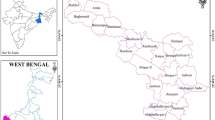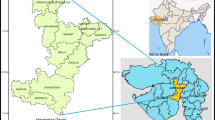Abstract
Assessment of the vulnerability of groundwater can be defined as the area’s rate of incorporation capacity to the impurity from surface overlying the aquifer. This study is of profound importance with regard to natural resource management and land use planning. This study deals with determining shallow aquifer vulnerability by using a DRASTIC model based on GIS in Tehsil Safdarabad of District Sheikhupura in Punjab. Within a local watershed, the quality of groundwater deteriorates as a result of various physical and environmental activities. This research, therefore, uses a combination of GIS and DRASTIC to estimate groundwater assessment. Seven hydrogeological data layers are being utilized as input to the model. The layers comprise Depth of water, net Recharge, Aquifer media, Soil media, Topography, Impact of vadose zone and Hydraulic Conductivity. DRASTIC index results would assist in determining pollution vulnerable zones. Research indicates about 11.32% of the research area is highly exposed, 34.4% is at moderate risk and 54.2% is at low risk exposure. Northern, northwestern and middle sectors of the area under consideration exhibited low aquifer susceptibility, whereas some areas in the southern and northeastern parts were highly vulnerable.









Similar content being viewed by others

References
Abdullah T et al (2015) Groundwater vulnerability mapping using lineament density on standard DRASTIC model: case study in Halabja Saidsadiq Basin, Kurdistan Region, Iraq. Engineering 7(10):644–667
Albinet M, Margat J (1970) Groundwater pollution vulnerability mapping. Bulletin du Bureau de Recherches Géologiques et Minières Bull BRGM 2nd Series 3(4):13–22
Aller L et al. (1987) DRASTIC: a standardized system for evaluating ground water pollution potential using hydrogeologic settings. US Environmental Protection Agency
Ashraf A, Ahmad Z (2008) Regional groundwater flow modelling of Upper Chaj Doab of Indus Basin, Pakistan using finite element model (Feflow) and geoinformatics. Geophys J Int 173(1):17–24
Azpurua MA, Ramos KD (2010) A comparison of spatial interpolation methods for estimation of average electromagnetic field magnitude. Progr Electromagn Res 14:135–145
CGWB M (2011) Ground water scenario in major cities of India. Central Ground Water Board, Ministry of Water Resources, Government of India
Childs C (2004) Interpolating surfaces in ArcGIS Spatial Analyst, ArcUser, p 35
Cosgrove WJ, Rijsberman FR (2014) World water vision: making water everybody's business. Routledge, London
Davis J (2005) Private-sector participation in the water and sanitation sector. Annu Rev Environ Resour 30:145–183
Duijvenbooden WV, Van Waegeningh H (1987) Vulnerability of soil and groundwater to pollutants. Verslagen en Mededelingen. Commissie voor Hydrologisch Onderzoek TNO (Netherlands)
El Mansouri B, Kili M, Chao J, Fekri A, Mridekh A (2013) Mathematical Models as Tools for Prevention and Risk Estimates of Groundwater Pollution: Contributions and Challenges. In: Scozzari A, Dotsika E (eds) Threats to the quality of groundwater resources, vol 42. The handbook of environmental chemistry. Springer, Berlin
Gautam SK et al (2015) Evaluation of groundwater quality in the Chotanagpur plateau region of the Subarnarekha river basin, Jharkhand State, India. Sustain Water Qual Ecol 6:57–74
Greenman D et al. (1967) Groundwater hydrology of the Punjab, West Pakistan, with emphasis on problems caused by canal irrigation: US Geol. Survey Water-Supply Paper
Hanif S (2013) 3D-regional groundwater modeling of Thal Doab, central indus basin. Bahria University Islamabad Campus, Punjab
Hernández-Espriú A et al (2014) The DRASTIC-Sg model: an extension to the DRASTIC approach for mapping groundwater vulnerability in aquifers subject to differential land subsidence, with application to Mexico City. Hydrogeol J 22(6):1469–1485
Hussain Y (2014) Hydrogeophysical investigations and GIS vulnerability mapping of Kot Addu. Quaid-i-Azam University, Islamabad
Hussain Y et al (2016a) Modelling the spatial distribution of arsenic in water and its correlation with public health, central Indus Basin, Pakistan. J Geosci Environ Protect 4:18–25
Hussain Y et al (2016b) Assessment of the pollution potential of an aquifer from surface contaminants in a geographic information system: a case study of pakistan. Geo-Chicago 2016:623–632
Hussain Y et al (2017) Modelling the vulnerability of groundwater to contamination in an unconfined alluvial aquifer in Pakistan. Environm Earth Sci 76(2):84
Mejia O et al (2007) Geostatistics techniques in bajo Cauca Antioqueño hydrogeology. DYNA 74(152):136–149
Nickson R et al (2005) Arsenic and other drinking water quality issues, Muzaffargarh District, Pakistan. Appl Geochem 20(1):55–68
Plymale CL, Angle M (2002) Groundwater pollution potential of Fulton County, Ohio. Ohio Department of Natural resources division of water, water resources section, Groundwater pollution potential report no 45
Polemio M, Casarano D, Limoni PP (2009) Karstic aquifer vulnerability assessment methods and results at a test site (Apulia, southern Italy). Nat Hazards Earth Syst Sci 9(4):1461–1470
Rahman A (2008) A GIS based DRASTIC model for assessing groundwater vulnerability in shallow aquifer in Aligarh, India. Appl Geogr 28(1):32–53
Saha D, Alam F (2014) Groundwater vulnerability assessment using DRASTIC and Pesticide DRASTIC models in intense agriculture area of the Gangetic plains, India. Environ Monit Assess 186(12):8741–8763
Samake M et al (2010) Assessment of groundwater pollution potential of the Datong Basin, Northern China. J Sustain Dev 3(2):140
Shekhawat M, Chundawat D (2015) Groundwater vulnerability assessment using DRASTIC method approach in and around Keoladev Ghana national park, Rajasthan, India. Int J Curr Res 7(8):19436–19443
Şimşek C (2007) The GIS-integrated surfacial aquifer potential mapping and its importance for aquifer protection, Küçük Menderes Basin/West Turkey. River Basin Management, International Congress
Singh A et al (2015) A modified-DRASTIC model (DRASTICA) for assessment of groundwater vulnerability to pollution in an urbanized environment in Lucknow, India. Environ Earth Sci 74(7):5475–5490
United Nations Development Programme (2016) Water security in Pakistan: issues and challenges. Retrieved from https://www.undp.org/content/dam/pakistan/docs/DevelopmentPolicy/DAP%20Volume3,%20Issue4%20English.pdf
Author information
Authors and Affiliations
Corresponding author
Additional information
Publisher's Note
Springer Nature remains neutral with regard to jurisdictional claims in published maps and institutional affiliations.
Rights and permissions
About this article
Cite this article
Aslam, B., Ismail, S. & Ali, I. A GIS-based DRASTIC model for assessing aquifer susceptibility of Safdarabad Tehsil, Sheikhupura District, Punjab Province, Pakistan. Model. Earth Syst. Environ. 6, 995–1005 (2020). https://doi.org/10.1007/s40808-020-00735-8
Received:
Accepted:
Published:
Issue Date:
DOI: https://doi.org/10.1007/s40808-020-00735-8



